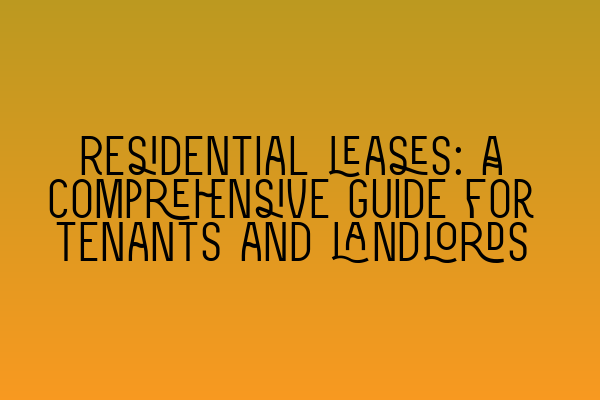Residential Leases: A Comprehensive Guide for Tenants and Landlords
Welcome to our comprehensive guide on residential leases for tenants and landlords. Whether you are a tenant looking to rent a property or a landlord seeking to lease out your property, understanding the key aspects of residential leases is crucial. In this guide, we will cover everything you need to know about residential leases, including their purpose, types, key terms, and legal obligations.
1. What is a Residential Lease?
A residential lease is a legally binding contract between a landlord and a tenant that grants the tenant the right to occupy a property for a specified period. It sets out the terms and conditions under which the tenant can use and enjoy the property, as well as the rights and responsibilities of both parties.
For tenants, a residential lease provides security of tenure and ensures they have a place to call home. On the other hand, landlords benefit from having a written agreement that establishes their rights and safeguards their property.
2. Types of Residential Leases
Residential leases can take various forms, depending on the specific needs and preferences of the parties involved. Here are the most common types:
a. Assured Shorthold Tenancy (AST)
The AST is the most common type of residential lease in England and Wales. It provides tenants with a minimum term of six months and grants the landlord the right to regain possession of the property after this fixed term, provided they follow the proper legal procedures.
ASTs offer flexibility for both tenants and landlords, making them a popular choice for short to medium-term tenancies.
b. Rent Act Protected Tenancy
Rent Act protected tenancies are usually long-term leases that were entered into prior to 15 January 1989. These tenancies offer tenants significant protection, including security of tenure and rent control.
It is important to note that there are very few Rent Act protected tenancies remaining, and they are generally not available for new tenancies.
3. Key Terms in a Residential Lease
Residential leases contain several essential terms that both tenants and landlords should understand. Here are some of the key terms:
a. Rent
The rent is the amount of money the tenant agrees to pay the landlord in exchange for the right to occupy the property. It is vital for both parties to agree on the rent amount and any specific terms related to its payment, such as due dates and acceptable payment methods.
b. Tenancy Term
The tenancy term refers to the duration for which the lease is granted. It is important for both parties to clearly define the start and end dates of the tenancy to avoid any confusion or disputes.
c. Security Deposit
A security deposit is a sum of money paid by the tenant to the landlord as a form of financial protection against any damages or unpaid rent. It is typically refundable at the end of the tenancy, minus deductions for any legitimate expenses.
d. Repairs and Maintenance
The responsibilities for repairs and maintenance should be clearly outlined in the lease. Generally, landlords are responsible for maintaining the property’s structure and common areas, while tenants are responsible for keeping the property clean and reporting any necessary repairs promptly.
4. Legal Obligations for Tenants and Landlords
Both tenants and landlords have legal obligations they must fulfill throughout the duration of the tenancy. Failure to meet these obligations can lead to disputes or legal consequences. Here are some of the key obligations:
a. Tenant’s Obligations
Tenants are legally obliged to:
- Pay rent on time and in full
- Take reasonable care of the property
- Report any damages or necessary repairs to the landlord
- Adhere to any terms related to pets, smoking, or subletting
b. Landlord’s Obligations
Landlords are legally obliged to:
- Ensure the property is fit for habitation
- Keep the property in good repair
- Protect the tenant’s deposit in a government-approved scheme
- Provide the tenant with required documentation, such as a gas safety certificate
5. Additional Considerations
There are additional considerations that tenants and landlords should keep in mind:
- Ending a Tenancy: Both tenants and landlords must follow the proper procedures for ending a tenancy. This usually involves giving notice within a specified timeframe.
- Dispute Resolution: In case of disagreements, tenants and landlords can seek mediation or take legal action through the appropriate channels.
For more information on residential leases, you may find the following related articles helpful:
- SQE 1 Practice Exam Questions
- SQE 1 Practice Mocks FLK1 FLK2
- SQE 2 Preparation Courses
- SQE 1 Preparation Courses
- SRA SQE Exam Dates
We hope this comprehensive guide has provided you with valuable insights into residential leases. For professional legal advice and assistance with residential leases, please contact SQE Property Law & Land Law. Our experienced solicitors are ready to help!
